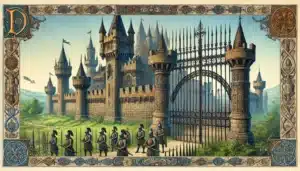Hello there! I’m Bill, a seasoned craftsman in the world of custom wrought iron. For decades, my hands have bent and shaped metal, creating fences that aren’t just barriers but pieces of art. But recently, something new has caught my attention – the green wave of environmental sustainability. This blog marks the beginning of a unique journey for me – one where I take my deep-rooted knowledge of metalwork and blend it with a growing understanding of environmental concerns. It’s a path I never expected to take, but here I am, ready to explore how my life’s work intersects with the pressing need to protect our planet.
The Legacy of Wrought Iron
My story with wrought iron began as a young apprentice, fascinated by the way fire and hammer could transform rigid metal into intricate designs. Over the years, I’ve seen trends come and go, but one constant has been the undeniable resilience of metal fencing. There’s something profoundly reliable about a wrought iron fence – its strength against the elements, its resistance to wear and tear, and its ability to stand the test of time. I recall a project from my early days, a majestic gate that still stands today, untouched by decades of harsh winters and scorching summers. This durability is where metal fencing truly shines, especially when compared to materials like wood or plastic, which crack, fade, and need replacing far more frequently. It’s this longevity and minimal need for replacement that first hinted to me there might be more to wrought iron than just its aesthetic appeal – perhaps even a hidden environmental edge.
The Awakening – Realizing the Environmental Impact
The turning point for me came unexpectedly. It was during a casual conversation with a younger colleague, an environmental enthusiast, who offhandedly mentioned the carbon footprint of various industries. That got me thinking: what was the impact of my own trade? I realized, despite my expertise in shaping metal, I knew little about its environmental implications.
Eager to fill this gap, I dove into research, scouring articles and studies. What I found was eye-opening. The metalworking industry, like many others, contributed to carbon emissions, resource consumption, and waste generation. This was a sobering realization. However, amidst these concerns, I also discovered areas where my trade could actually benefit the environment. This was the glimmer of hope that propelled me further into learning about sustainable practices.
Metal Fencing and the Environment – What I Learned
As I delved deeper into the intersection of metalworking and environmentalism, several key benefits of metal fencing emerged.
Recyclability of Metals: One of the most striking facts I came across was about the recyclability of metals like iron and steel. I learned that these materials can be recycled almost indefinitely without losing their quality. This means that old fences or scrap pieces can be transformed into new products, significantly reducing the need for virgin materials and the environmental degradation associated with mining and processing.
Longevity and Reduced Replacement Frequency: Another environmental boon of metal fencing is its longevity. A well-constructed iron fence can last for decades, even centuries. This durability translates to less frequent replacements compared to fences made from materials like wood or vinyl. The less often we need to replace our fences, the less strain we put on resources and the lower our overall environmental impact.
Minimal Maintenance: Metal fences require remarkably less upkeep than other types. They don’t need regular treatments or coatings to protect them from the elements, unlike wooden fences that require staining or sealing. This not only saves time and money but also reduces the use of potentially harmful chemicals often used in maintenance products.
To back these claims, I found compelling statistics. For instance, the recycling rate for steel, the primary component of wrought iron, is over 60% globally, contributing significantly to resource conservation. Moreover, the longevity of metal products reduces the frequency of replacement by approximately three times compared to wood, based on industry life cycle assessments.
Through this learning journey, it became clear that while the metalworking industry does have its environmental drawbacks, aspects like recyclability, durability, and minimal maintenance of metal fencing offer substantial environmental benefits. These are the insights I aim to integrate more deeply into my craft, aligning my lifelong passion for metalworking with a newfound commitment to sustainability.
Sustainable Practices in the Metalwork Industry
The metalwork industry is undergoing a transformative shift towards sustainability. Across the board, workshops are re-evaluating their practices, starting with the sourcing of materials. A growing number of businesses are now prioritizing suppliers who provide recycled metals. This not only supports the recycling industry but also significantly reduces the environmental impact associated with mining and processing new materials.
Energy efficiency is another area where the industry is making strides. Many workshops have upgraded to energy-efficient tools and machinery, optimizing their processes to cut down on energy waste. Simple changes, like grouping similar tasks to reduce the need for repeated heating in forges, are resulting in substantial energy savings.
Waste reduction is also a key focus. The industry is adopting more efficient planning and fabrication techniques to minimize offcuts. The scrap metal that is produced is increasingly being recycled or creatively repurposed, thereby contributing to a circular economy and reducing landfill waste.
The Future of Fencing – Eco-Friendly Innovations in Metalwork
The future of metalwork, particularly in fencing, is being shaped by eco-friendly innovations. New technologies are emerging that are not only more efficient but also kinder to the environment. For instance, the use of solar-powered equipment and eco-friendly, non-toxic coatings are becoming more prevalent, reflecting the industry’s commitment to sustainability.
There’s also a growing trend of collaboration between metalwork professionals and eco-conscious designers and suppliers. These collaborations are fostering the development of new, sustainable fencing options. By combining traditional materials like metal with reclaimed or recycled materials, the industry is creating unique, environmentally responsible products.
Balancing Tradition with Progress in the Metalwork Industry
The metalwork industry is striking a balance between preserving traditional craftsmanship and adopting sustainable practices. This evolution reflects an understanding that honoring the past doesn’t mean resisting change. Instead, it’s about adapting the core principles of the craft to meet contemporary environmental needs.
The industry is encouraging professionals, clients, and other stakeholders to consider the environmental impacts of their choices. By integrating sustainability into every aspect of metalworking, from material selection to production processes, the industry is not only respecting its rich heritage but also contributing positively to the future of our planet. This shift towards eco-friendly practices demonstrates a commitment to ensuring that the art of metalwork continues to thrive in a way that is responsible, relevant, and respectful of the environment.
Conclusion: Forging a Greener Future in Metalwork
As the metalwork industry embraces these sustainable practices, it’s clear that we are on the cusp of a significant transformation. This shift towards eco-friendliness in the world of metal fencing is not just about adopting new technologies or methods; it’s about a deeper change in perspective. It’s about understanding that our craft can and should coexist harmoniously with the environment. This journey of integrating sustainability into metalwork is a testament to the industry’s ability to evolve while maintaining its core values of durability, artistry, and quality.
We’re witnessing an era where traditional craftsmanship meets modern environmental responsibility, creating a synergy that benefits both our heritage and our planet. By choosing sustainable options, we’re not just making a statement about our personal or professional values; we’re contributing to a larger movement towards a more sustainable future.
Connect with Irish Iron for Sustainable Metalwork Solutions
If you’re inspired by the prospect of eco-friendly metal fencing, or if you’re looking to incorporate sustainable practices into your own projects, we invite you to reach out to Irish Iron. At Irish Iron, we are committed to leading the way in sustainable metalwork. We offer a range of environmentally conscious options, ensuring that our products are not only aesthetically pleasing but also eco-friendly. Whether you’re seeking advice, looking to commission a project, or simply exploring sustainable options, our team is here to help.
Contact Irish Iron today to learn more about how we can bring sustainable elegance to your space. Together, let’s forge a greener future, one project at a time.



